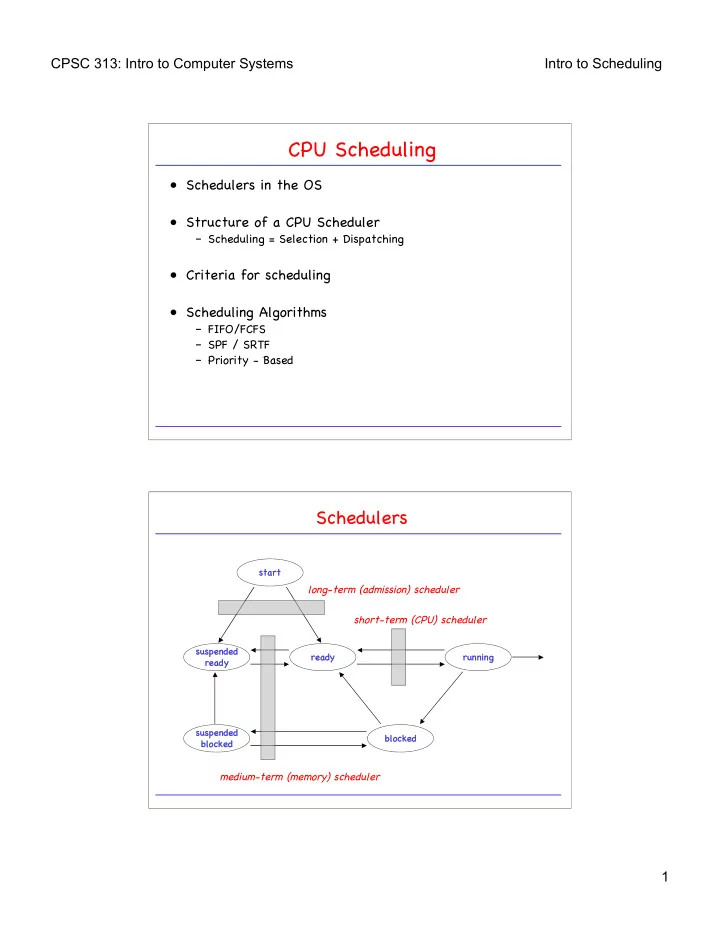

CPSC 313: Intro to Computer Systems Intro to Scheduling CPU Scheduling • Schedulers in the OS • Structure of a CPU Scheduler – Scheduling = Selection + Dispatching • Criteria for scheduling • Scheduling Algorithms – FIFO/FCFS – SPF / SRTF – Priority - Based Schedulers start long-term (admission) scheduler short-term (CPU) scheduler suspended ready running ready suspended blocked blocked medium-term (memory) scheduler 1
CPSC 313: Intro to Computer Systems Intro to Scheduling Focus: Short-Term Scheduling • Recall: Motivation for multiprogramming -- have multiple processes in memory to keep CPU busy. • Typical execution profile of a process/thread: start terminate wait for I/O wait for I/O wait for I/O CPU burst CPU burst CPU burst CPU burst • CPU scheduler is managing the execution of CPU bursts, represented by processes in ready or running state. Scheduling Decisions “Who is going to use the CPU next?!” 4 2 ready running 3 1 waiting non-preemptive Scheduling decision points: – 1. The running process changes from running to waiting preemptive (current CPU burst of that process is over). – 2. The running process terminates. – 3. A waiting process becomes ready (new CPU burst of that process begins). – 4. The current process switches from running to ready . 2
CPSC 313: Intro to Computer Systems Intro to Scheduling Structure of a Scheduler ready queue PCB scheduler dispatcher CPU select process start new process ? ? What Is a Good Scheduler? Criteria • User oriented: – Turnaround time : time interval from submission of job until its completion – Waiting time : sum of periods spent waiting in ready queue – Response time : time interval from submission of job to first response – Normalized turnaround time: ratio of turnaround time to service time • System oriented: – CPU utilization : percentage of time CPU is busy – Throughput : number of jobs completed per time unit • Any good scheduler should: – maximize CPU utilization and throughput – minimize turnaround time, waiting time, response time • Huh? – maximum/minimum values vs. average values vs. variance 3
CPSC 313: Intro to Computer Systems Intro to Scheduling Scheduling Algorithms • FCFS : First-come-first-served • SPN: Shortest Process Next • SRT: Shortest Remaining Time • priority scheduling • RR : Round-robin • MLFQ: Multilevel feedback queue scheduling • Multiprocessor scheduling First-Come-First-Served (FCFS/FIFO) append at the end of queue head tail CPU PCB • Advantages: – very simple • Disadvantages: – long average and worst-case waiting times – poor dynamic behavior (convoy effect) 4
CPSC 313: Intro to Computer Systems Intro to Scheduling Shortest Process Next determine location in queue (compare next CPU burst lengths) CPU long jobs short jobs • Whenever CPU is idle, picks process with shortest next CPU burst . • Advantages: minimizes average waiting times. • Problem: How to determine length of next CPU burst?! • Problem: Starvation of jobs with long CPU bursts. SJF Minimizes Average Waiting Time • Provably optimal: Proof: swapping of jobs P long P short P short P long dW = t short - t long < 0 • Example: 6 12 8 4 W = 6+18+26 = 50 6 8 12 4 W = 6+14+26 = 46 6 8 4 12 W = 6+14+18 = 38 6 4 8 12 W = 6+10+18 = 34 4 6 8 12 W = 4+10+18 = 32 5
CPSC 313: Intro to Computer Systems Intro to Scheduling (Fixed) Priority Scheduling Selector (compare priorities) CPU low priority high priority • Whenever CPU is idle, picks process with highest priority. • Priority: – process class, urgency, pocket depth. • Unbounded blocking: Starvation – Increase priority over time: aging • Conceptually • Priority Queues priority queue low priority priority low priority q=f(p) (compare priorities) (compare priorities) Selector Selector high priority high priority CPU CPU 6
CPSC 313: Intro to Computer Systems Intro to Scheduling Round-Robin • FIFO with preemption after time quantum • Method for time sharing • Choice of time quantum: – large: FCFS – small: Processor sharing • Time quantum also defines context-switching overhead FIFO queue end of time quantum CPU terminate Multilevel Feedback Queue Scheduling (conceptually) low priority FCFS (quantum = infinity) (compare priorities) quantum = 16 ms Selector aging quantum = 4ms quantum = 2 ms demotion high priority 7
Recommend
More recommend